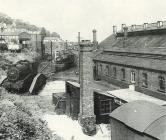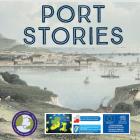Content can be downloaded for non-commercial purposes, such as for personal use or in educational resources.
For commercial purposes please contact the copyright holder directly.
Read more about the The Creative Archive Licence.
Description
Lede
More than a century ago in the midst of the race for ever-faster transatlantic travel, Fishguard achieved global fame when the Mauretania sailed in from New York.
Story
In August 1909, the port of Fishguard in Pembrokeshire hit the headlines. The Cunard Steamship Company had chosen Fishguard as its first port-of-call for its Atlantic liners. In its inaugural crossing from New York to Fishguard, the Cunard ship Mauretania gained the much-coveted Blue Riband for the fastest Atlantic passage time of 4 days and 14 hours. Supported by a network of sea and rail, Fishguard was now widely praised for bringing New York and London closer than ever before.
Ocean liners had sailed from Fishguard for some years, but the Mauretania was the first North Atlantic liner to connect with New York. The Daily Mail described scenes of excitement as it was first sighted on the headland on 30 August 1909: ‘her four great red funnels with their black tops were sighted round Strumble Head. Every point of vantage from the cliffs on the Goodwick side to the ruined fort on the old Fishguard side was lined with people, whose cheers crossed the dancing blue waves, borne on the brisk southerly breeze to greet the Cunarder.’
Fishguard bubbled over with enthusiasm as the Mauretania’s passengers were ferried to shore. Ten local women in Welsh costume presented sprigs of white and purple heather to the passengers as they landed, flags hung from every house, local lifeboats danced on the waves and the Territorial Artillery fired a salute. The first passenger off the liner was Jenkin Evans, a western farmer. When greeted by cheers from those on shore, he said, ‘I left Lampeter forty-three years ago, and I am returning to Wales from Kansas City.’
Immortalised in verse by Rudyard Kipling as a ‘monstrous nine-decked city,’ the Mauretania was a symbol of modernity but it was also designed to suit the lavish tastes of its Edwardian upper-class passengers. It was decorated with marble, wood panelling and tapestries, and boasted a fully stocked library, elegant drawing rooms and a veranda café. However, passengers of all classes made the transatlantic crossing. They travelled for leisure purposes, as emigrants looking to find work, or to join family members who had travelled before them.
When passengers arrived at Fishguard, three Great Western Railway express trains were waiting to convey them to London Paddington. The GWR played an important role in turning Fishguard into a purpose-built ocean liner port, drawing traffic away from its rivals Liverpool, Plymouth and Southampton. Good connections between ship and rail cut passengers’ waiting and travelling times. They also aided the distribution of news, as the Mauretania brought with it almost 2,000 bags of mail which were speedily distributed across the country.
Across the Atlantic, the New York Herald praised the speed of the liner’s crossing, stating that ‘the adoption of the new and little-known port by the premier steamship company is a matter of great importance.’ The route was shorter than its competitors, at only 2,902 nautical miles, and also occupied a central position between Queenstown – now Cobh, County Cork – and Liverpool. Painstaking and expensive modifications made to Fishguard’s harbour by the GWR Company included an enormous breakwater to shelter it from the north, creating a sheltered channel of six miles of deep water.
The media coverage of the arrival of the Mauretania at Fishguard indicates that expectations around the port were high. It had been hoped that Fishguard would become the new epicentre of transatlantic travel but within a few years, opposition from its rivals and rising costs made it hard for Fishguard to compete. In 1914, the outbreak of the First World War put an end to Fishguard’s transatlantic ambitions. As passenger crossings and leisure travel ground to a halt, the Mauretania was repurposed as a troop ship. Those who worked on the Cunard Line and the GWR signed up to fight, and Fishguard and its neighbour Goodwick found new purpose, this time as sea-plane stations, patrolling for U-boats between St George’s Channel
and the Irish Sea.
Factoid
- The GWR’s modifications at Fishguard also provided a quick and comfortable route to Ireland for travellers from London. The sea-passage was reduced to 54 nautical miles and was hailed as ‘a new epoch in the history of Ireland’ by The Times.
- The completion of the South Wales section of the GWR Company realised the ambition of engineer Isambard Kingdom Brunel, who had hoped Fishguard would become the terminus of the line.





Do you have information to add to this item? Please leave a comment
Comments (0)
You must be logged in to leave a comment